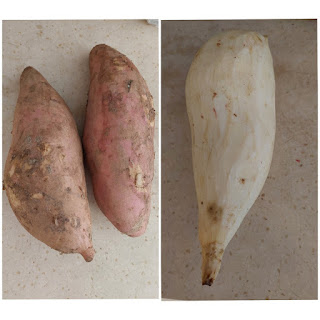叉烧
I have made countless char siu using this recipe and am pretty sure you will love it, just like my family.
The ingredients for the marinade, while it looks long, are readily available in my kitchen. I don't have to buy bottles/tubs of red fermented beancurd specifically for this dish! Most importantly, this recipe does not use food colouring, oyster or hoisin sauce (which contains MSG monosodium glutamate, food flavoring and preservatives).
There are two ways to make this dish: roasting/grilling in oven and cooking over the stove.
Ingredients
1.2kg pork (I requested butcher for 不见天, a cut of meat around the pig's armpit which has good amount of fat. Slab of pork belly will do too)
2 teaspoon molasses
1 teaspoon sesame oil
1 teaspoon salt
1 teaspoon dark soy sauce
2 tablespoon honey
2 tablespoon sugar (I use jaggery)
1 tablespoon chinese wine (I use 绍兴花彫酒)
1/4 teaspoon five spice powder
4 cloves of garlic (chopped finely or minced/grated)
1 teaspoon paprika (optional)
2 tablespoon warm water
1/2 piece fermented tofu (optional)
1 tablespoon fermented tofu juice (optional)
1 spoonful of love
Method (Roasting/Grilling in Oven)
1. Slice the pork into strips of 1.5 to 2 inch wide.
2. Use the sharp tip of the knife to poke the meat lightly to help the meat absorb the marinade.
3. Combine all the ingredients with the pork and marinade overnight in fridge.
4. The next day, take the pork out from fridge half hour before roasting*. Preheat oven to 200 degree celsius. Keep the remaining marinade to baste the pork during roasting later.
5. Line baking pan with aluminum foil and place a wire rack (I use two steaming racks) on the pan. Then lay the pork on the wire rack and pour some water to the bottom of tray.
6. Roast (fan mode) at 200 degree celsius for 15 minutes. Then flip the pork over, baste marinade and roast for another 15 minutes. Try: 200C for 20mins, flip and baste every 5 minutes.
7. Add 1 tablespoon maltose (substitute: honey) to the leftover marinade and mix until dissolve. Once the pork has been roasted for 30minutes, brush the marinade all over the pork and grill for 5 minutes. Repeat the basting and roasting (for 5 minutes) until the char siu is charred to your liking.
8. Rest the char siu for 15 minutes before slicing them and serving.
Method (Cooking Over Stove)
1. Heat up wok with 2 tablespoons of cooking oil. Then place the pork into the wok including all the marinade. Simmer for 40-45minutes until the pork is tender. The marinade should thicken.
2. Remove the marinade from the wok, raise the stove heat to medium and sear the sides of the pork until they are nicely charred. This should take not more than 5 minutes.
3. Add 1 tablespoon maltose (substitute: honey) to the leftover marinade and mix until dissolve. Brush the marinade all over the pork.
4. Rest the char siu for 15 minutes before slicing them and serving.

















































